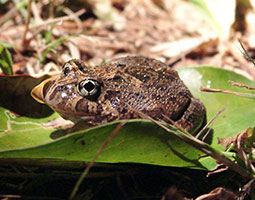Adelotus brevis
Description

The Tusked Frog (Adelotus brevis) is a ground dwelling frog that inhabits wet schlerophyll forests that have small pools of water such as ponds and intermittent streams. Their distribution is relatively broad ranging from Mackay to just north of Sydney.
These frogs are small and round and can grow to up to 50mm in length. Their skin is bumpy, and is a variegated colour pattern of brown, grey, olive and beige. In contrast to this the belly is a mottled black and white/grey and the groin and calves are mottled red and black. Their distinguishing feature is a pair of tusks found on the lower Jaw of both males and females that are only apparent when their mouths are open.
Breeding occurs in Spring to Summer where males build a hidden nest in the leaf litter of the waterway and attract females with a “p-tuk” call. The egg mass is a large foamy clump laid in the nest that is then protected by the male until the tadpoles hatch.
Adaptations
- Have lost the webbing from between their toes as they are ground dwelling frogs and it impedes movement
- Males use their tusks to defend territory from other male frogs
- Colouration and texture of skin provides great camouflage in the surrounding soil and leaf litter
- They are the only Australian frog where the male is bigger than the female.
Feeding relationships
What I eat: Living insects, crustaceans and other invertebrates (e.g. spiders)
What eats me: Frogspawn is eaten by ants, fish, small rds and birds. Tadpoles are eaten by pond fish, birds, water spiders, and water bugs (e.g. dragonfly larvae). Adult frogs are eaten by snakes, birds (e.g. kookaburra, butcher bird, magpie), bats, goannas, rats, other frogs, cane toads, fish and domestic pets.
Interesting facts
The Tusked Frog is listed as “near threatened” due to habitat loss and the amphibian chytrid fungus which has decimated its population in many parts of its range. This fungus has been proposed as a potential cause of the dramatic decline of frogs world-wide, and infects 30% of all frog species.